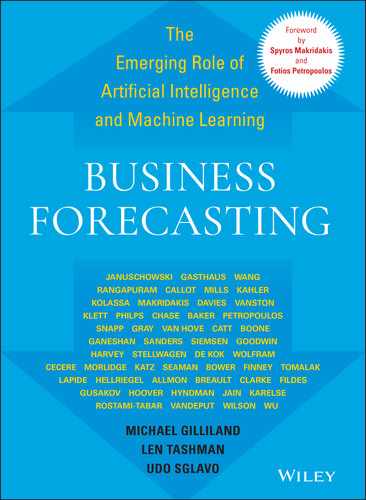Discover the role of machine learning and artificial intelligence in business forecasting from some of the brightest minds in the field In Business Forecasting: The Emerging Role of Artificial Intelligence and Machine Learning accomplished authors Michael Gilliland, Len Tashman, and Udo Sglavo deliver relevant and timely insights from some of the most important and influential authors in the field of forecasting. You'll learn about the role played by machine learning and AI in the forecasting process and discover brand-new research, case studies, and thoughtful discussions covering an array of practical topics. The book offers multiple perspectives on issues like monitoring forecast performance, forecasting process, communication and accountability for forecasts, and the use of big data in forecasting. You will find: In addition to the Foreword by renowned researchers Spyros Makridakis and Fotios Petropoulos, the book also includes 16 "opinion/editorial" Afterwords by a diverse range of top academics, consultants, vendors, and industry practitioners, each providing their own unique vision of the issues, current state, and future direction of business forecasting. Perfect for financial controllers, chief financial officers, business analysts, forecast analysts, and demand planners, Business Forecasting will also earn a place in the libraries of other executives and managers who seek a one-stop resource to help them critically assess and improve their own organization's forecasting efforts.
Table of Contents
- Cover
- Title Page
- Copyright
- Dedication
- Foreword
- Preface
- State of the Art
- CHAPTER 1: Artificial Intelligence and Machine Learning in Forecasting
- 1.1 DEEP LEARNING FOR FORECASTING
- 1.2 DEEP LEARNING FOR FORECASTING: CURRENT TRENDS AND CHALLENGES
- 1.3 NEURAL NETWORK–BASED FORECASTING STRATEGIES
- 1.4 WILL DEEP AND MACHINE LEARNING SOLVE OUR FORECASTING PROBLEMS?
- 1.5 FORECASTING THE IMPACT OF ARTIFICIAL INTELLIGENCE: THE EMERGING AND LONG-TERM FUTURE
- 1.6 FORECASTING THE IMPACT OF ARTIFICIAL INTELLIGENCE: ANOTHER VOICE
- 1.7 SMARTER SUPPLY CHAINS THROUGH AI
- 1.8 CONTINUAL LEARNING: THE NEXT GENERATION OF ARTIFICIAL INTELLIGENCE
- 1.9 ASSISTED DEMAND PLANNING USING MACHINE LEARNING
- 1.10 MAXIMIZING FORECAST VALUE ADD THROUGH MACHINE LEARNING AND BEHAVIORAL ECONOMICS
- 1.11 THE M4 FORECASTING COMPETITION – TAKEAWAYS FOR THE PRACTITIONER
- REFERENCES
- NOTES
- CHAPTER 2: Big Data in Forecasting
- CHAPTER 3: Forecasting Methods: Modeling, Selection, and Monitoring
- 3.1 KNOW YOUR TIME SERIES
- 3.2 A CLASSIFICATION OF BUSINESS FORECASTING PROBLEMS
- 3.3 JUDGMENTAL MODEL SELECTION
- 3.4 A JUDGMENT ON JUDGMENT
- 3.5 COULD THESE RECENT FINDINGS IMPROVE YOUR JUDGMENTAL FORECASTS?
- 3.6 A PRIMER ON PROBABILISTIC DEMAND PLANNING
- 3.7 BENEFITS AND CHALLENGES OF CORPORATE PREDICTION MARKETS
- 3.8 GET YOUR CoV ON …
- 3.9 STANDARD DEVIATION IS NOT THE WAY TO MEASURE VOLATILITY
- 3.10 MONITORING FORECAST MODELS USING CONTROL CHARTS
- 3.11 FORECASTING THE FUTURE OF RETAIL FORECASTING
- NOTES
- CHAPTER 4: Forecasting Performance
- CHAPTER 5: Forecasting Process: Communication, Accountability, and S&OP
- 5.1 NOT STORYTELLERS BUT REPORTERS
- 5.2 WHY IS IT SO HARD TO HOLD ANYONE ACCOUNTABLE FOR THE SALES FORECAST?
- 5.3 COMMUNICATING THE FORECAST: PROVIDING DECISION MAKERS WITH INSIGHTS
- 5.4 AN S& OP COMMUNICATION PLAN: THE FINAL STEP IN SUPPORT OF COMPANY STRATEGY
- 5.5 COMMUNICATING FORECASTS TO THE C-SUITE: A SIX-STEP SURVIVAL GUIDE
- 5.6 HOW TO IDENTIFY AND COMMUNICATE DOWNTURNS IN YOUR BUSINESS
- 5.7 COMMON S& OP CHANGE MANAGEMENT PITFALLS TO AVOID
- 5.8 FIVE STEPS TO LEAN DEMAND PLANNING
- 5.9 THE MOVE TO DEFENSIVE BUSINESS FORECASTING
- NOTES
- Afterwords
- OBSERVATIONS FROM A CAREER PRACTITIONER: KEYS TO FORECASTING SUCCESS
- DEMAND PLANNING AS A CAREER
- REFERENCE
- HOW DID WE GET DEMAND PLANNING SO WRONG?
- BUSINESS FORECASTING: ISSUES, CURRENT STATE, AND FUTURE DIRECTION
- STATISTICAL ALGORITHMS, JUDGMENT AND FORECASTING SOFTWARE SYSTEMS
- REFERENCES
- THE <<EASY BUTTON>> FOR FORECASTING
- REFERENCES
- THE FUTURE OF FORECASTING IS ARTIFICIAL INTELLIGENCE (AI) COMBINED WITH HUMAN FORECASTERS
- REFERENCES
- QUANTILE FORECASTING WITH ENSEMBLES AND COMBINATIONS
- REFERENCES
- MANAGING THE DEMAND FOR NEW PRODUCTS
- SOLVING FOR THE IRRATIONAL: WHY BEHAVIORAL ECONOMICS IS THE NEXT BIG IDEA IN DEMAND PLANNING
- BUSINESS FORECASTING IN DEVELOPING COUNTRIES
- REFERENCES
- DO THE PRINCIPLES OF ANALYTICS APPLY TO FORECASTING?
- GROUPTHINK ON THE TOPIC OF AI/ML FOR FORECASTING
- TAKING DEMAND PLANNING SKILLS TO THE NEXT LEVEL
- NOTES
- REFERENCES
- UNLOCK THE POTENTIAL OF BUSINESS FORECASTING
- BUILDING A DEMAND PLAN STORY FOR S&OP: THE BUSINESS VALUE OF ANALYTICS
- About the Editors
- Index
- End User License Agreement
